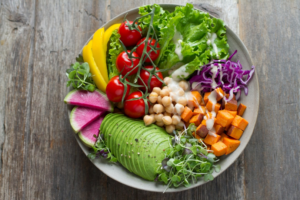When it comes to diabetes, medication is not the sole intervention. Lifestyle habits, especially exercise and diet, play a major role in the prevention and management of diabetes. You’ve probably come across plenty of information online on how to eat as a pre-diabetic or diabetic, and this article will look at one of those diets in particular: the plant-based diet.
What is a plant-based diet?
Before we go into its pros and cons, what exactly is a plant-based diet? Biochemist Thomas Colin Campbell coined the term plant-based in 1980 to describe a diet consisting of whole food, non-animal product ingredients. It is rich in fruits, vegetables, grains, legumes, nuts, and seeds, with the primary goal of boosting an individual’s overall health and well-being through simple and natural food.
Studies throughout the years have backed up the correlation of chronic illness and the standard American diet — one that is rich in meat and processed food with inadequate nutritional value — and this only continues to grow in number and importance. Furthermore, Maryville University draws attention to the estimated 164 million Americans that will be living with a chronic illness by 2025, which is more than half the entire population of the country. It only goes to show that drastic action going beyond the scope of medicine needs to be taken now. It’s important to remember that individual choices, like dietary changes, matter in public health. In this regard, many believe that going plant-based offers an alternative solution to this rising epidemic, with diabetes as one of the conditions it aims to alleviate.
How can it help people with diabetes?
The findings of a 2019 Harvard T. H. Chan School of Public Health study indicate that individuals who followed a strict diet of whole food plant-based ingredients exhibited a 23% lower risk of type 2 diabetes than those who didn’t follow this nutrition program. Researchers related the findings to improved insulin sensitivity and blood pressure, which are key factors to the development of diabetes.
Going plant-based may give pre-diabetics and diabetics a leg up over standard diets because many of the ingredients available are naturally low-glycemic. It means that these don’t cause abnormal spikes in blood sugar levels. Some examples of these ingredients include:
– whole grains, rice, and unprocessed breakfast cereals;
– fruit such as apples, plums, and pears;
– vegetables such as carrots, cauliflower, and zucchini;
– select starchy vegetables like yams and sweet potatoes;
– beans and legumes; and
– pasta and noodles.
However, one of the major disadvantages of plant-based diets is the amount of planning it entails. Without forethought, it’s easy to miss out on key nutrients, like protein and healthy fats. You might end up eating too much carbohydrates, which Healthline explains is a culprit behind high blood sugar. Food like white bread, instant oats, sugary cereals, and processed snacks are easy to eat on the go. However, while technically plant-based, these are high-glycemic food items that can be dangerous to people at risk of or living with diabetes.
It is also worth noting that meat and fish are low-glycemic as they contain virtually no carbohydrates. You might have more success by focusing on protein-rich food, too, as a successful participant of the Diabetes Prevention Program (DPP) did by doubling the amount of turkey slices he ate instead of eating two sandwiches with more bread. The disadvantage to eating meat, however, is that it may raise blood pressure. Meat and processed food tend to be high in cholesterol, while plants have virtually none of it.
The bottom line
At the end of the day, the secret to a successful plant-based diet for pre-diabetics, diabetics, and people who just want to improve their health is planning. Make sure you’re getting all the essential nutrients and avoiding processed food — and your body will definitely thank you.
Specially written for MountainWise.org
Author: Ximena Faith

